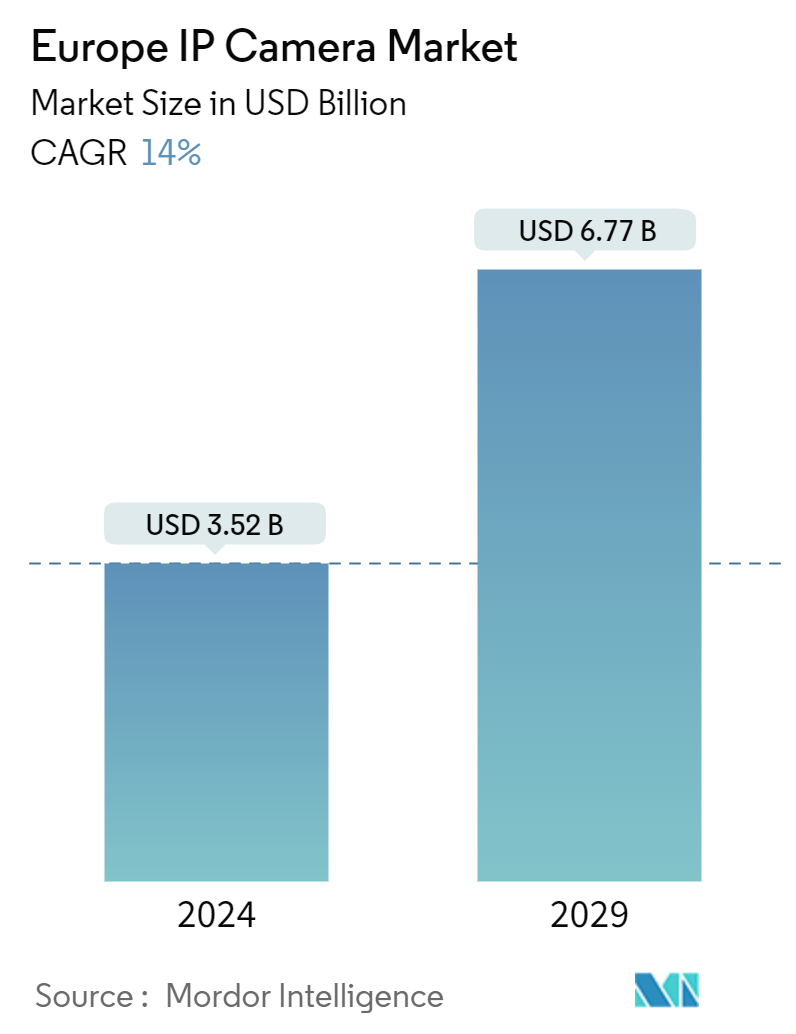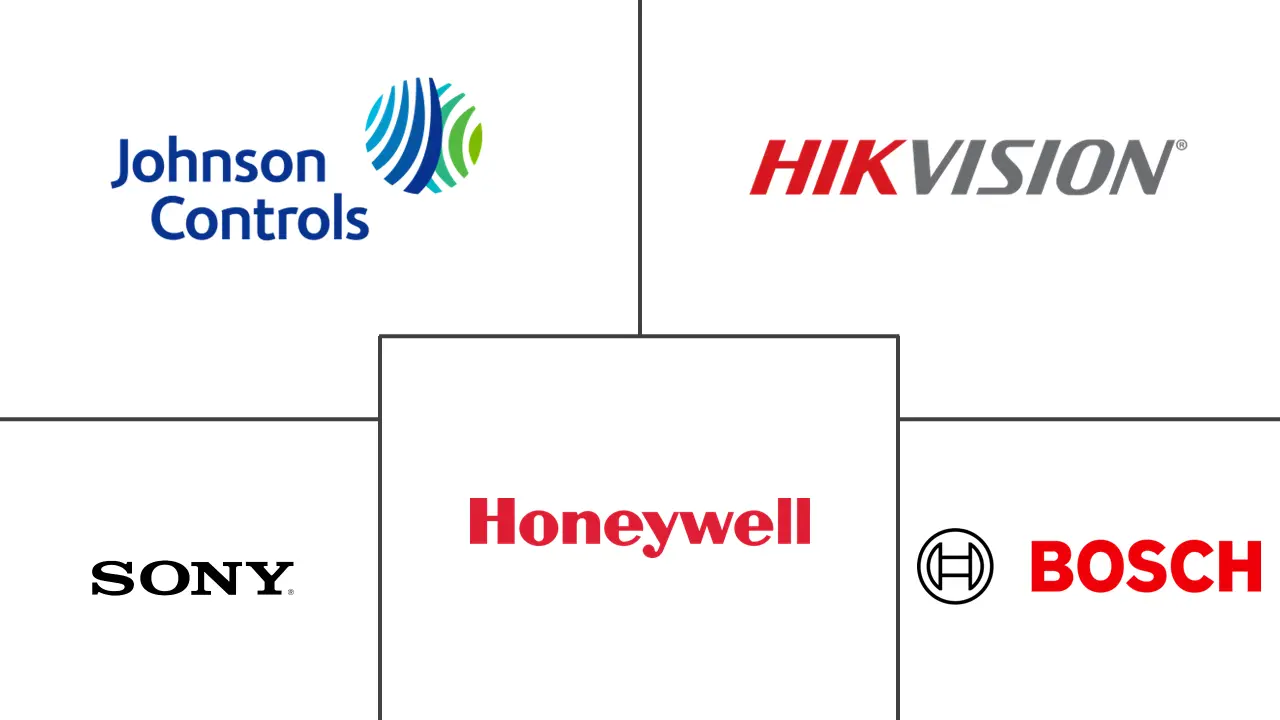Market Size of Europe IP Camera Industry

| Study Period | 2019 - 2029 |
| Base Year For Estimation | 2023 |
| Market Size (2024) | USD 3.52 Billion |
| Market Size (2029) | USD 6.77 Billion |
| CAGR (2024 - 2029) | 14.00 % |
| Market Concentration | Low |
Major Players
*Disclaimer: Major Players sorted in no particular order |
Europe IP Camera Market Analysis
The Europe IP Camera Market size is estimated at USD 3.52 billion in 2024, and is expected to reach USD 6.77 billion by 2029, growing at a CAGR of 14% during the forecast period (2024-2029).
• IP (Internet Protocol) is a digital security camera that transmits video through an IP network. These cameras are used for surveillance purposes. Unlike traditional CCTV cameras, IP cameras do not need a separate recording device; only a local network is required. IP cameras connect to a network in a similar manner as phones and computers do. With increasing concerns about safety and security at the individual and organizational levels, there's a growing need for surveillance systems, including IP cameras, to monitor and protect properties, assets, and people.
• Government regulations compliance and industry standards related to security and surveillance, especially in public places, transportation hubs, and critical infrastructure, drive the adoption of IP cameras for compliance and risk management. Moreover, the ongoing advancements in IP camera technology, such as higher resolutions, improved image quality, better low-light performance, advanced analytics capabilities, and integration with other security systems, make IP cameras more practical for various applications.
• Cameras are rising in the region due to growing industry security concerns. The industry's transition to IP cameras has brought hardware innovations that offer improved performance in low-light conditions, object tracking, and built-in security features. Technology advancements have led to the development of specialized surveillance cameras that can zoom in and scan items like dangerous equipment. These factors are predicted to drive the market's growth.
• Regulatory compliance with data protection regulations, privacy laws, and industry standards can pose challenges for IP camera deployments, especially in sectors such as finance, healthcare, and government, where strict rules govern the handling of sensitive information. Ensuring compliance with regulatory requirements adds complexity and cost to IP cameras. Furthermore, while IP cameras offer enhanced security features compared to analog cameras, the cameras are also vulnerable to cyber threats such as hacking, unauthorized access, and data breaches. Concerns about cybersecurity and privacy may deter some users from adopting IP cameras.
• Macroeconomic factors, such as heightened security concerns, including crime, terrorism, and public safety threats, increase the demand for surveillance solutions in the region. IP cameras are crucial in deterring and detecting security incidents and providing evidence for law enforcement investigations. Moreover, government policies related to surveillance and data protection impact the adoption of IP cameras in Europe. Compliance regulations such as the GDPR (General Data Protection Regulation) require careful consideration of data privacy and security requirements, influencing IP camera design deployment and use.
Europe IP Camera Industry Segmentation
For market estimation, we have tracked the revenue generated from the sale of types of IP cameras offered by different market players for a diverse range of applications. The market trends are evaluated by analyzing the investments made in product innovation, diversification, and expansion. Further, the advancements in residential, commercial, and industrial end-user industries are also crucial in determining the growth of the studied market.
The European IP camera market is segmented by type (fixed, Pan-Tilt-Zoom (PTZ), varifocal), end-user industry (residential, commercial, industrial, government, and law enforcement), and country (United Kingdom, Germany, France, and Italy). The report offers the market size and forecasts for all the above segments in value (USD).
| By Type | |
| Fixed | |
| Pan-Tilt-Zoom (PTZ) | |
| Varifocal |
| By End-User Industry | |
| Residential | |
| Commercial (BFSI, Education, Healthcare, Real Estate, Retail, and others) | |
| Industrial | |
| Government and Law Enforcement |
| By Country | |
| United Kingdom | |
| Germany | |
| France | |
| Italy |
Europe IP Camera Market Size Summary
The European IP camera market is poised for significant growth, driven by increasing security concerns and the need for advanced surveillance solutions across various sectors. IP cameras, which transmit video through IP networks, are becoming essential for monitoring and protecting properties, assets, and individuals. The shift from traditional CCTV to IP cameras is fueled by technological advancements that offer improved image quality, better low-light performance, and integration with other security systems. These cameras are particularly important in sectors such as finance, healthcare, and government, where regulatory compliance and data protection are critical. However, challenges such as cybersecurity threats and compliance with stringent privacy laws like GDPR add complexity to their deployment.
The commercial sector is experiencing a surge in demand for IP cameras, driven by the need for innovative security technologies to combat retail theft and enhance security in banking and other industries. The integration capabilities of IP cameras with access control systems, alarm systems, and analytics platforms are crucial for creating comprehensive security solutions. Germany, as a leader in Industry 4.0 and smart city initiatives, is at the forefront of adopting IP cameras, leveraging their advanced features for operational efficiency and public safety. The competitive landscape of the European IP camera market is characterized by the presence of major players like Johnson Controls, Honeywell, and Sony, who are expanding their market share through collaborations, partnerships, and the introduction of innovative products.
Europe IP Camera Market Size - Table of Contents
-
1. MARKET INSIGHTS
-
1.1 Market Overview
-
1.2 Industry Attractiveness - Porter's Five Force Analysis
-
1.2.1 Threat of New Entrants
-
1.2.2 Bargaining Power of Consumers
-
1.2.3 Bargaining Power of Suppliers
-
1.2.4 Threat of Substitute Products
-
1.2.5 Intensity of Competitive Rivalry
-
1.2.6 Threat of New Entrants
-
-
1.3 Industry Value Chain Analysis
-
1.4 Technological Advancements
-
1.5 Impact of COVID-19 aftereffects and Macro Economic Trends on the Industry
-
-
2. MARKET SEGMENTATION
-
2.1 By Type
-
2.1.1 Fixed
-
2.1.2 Pan-Tilt-Zoom (PTZ)
-
2.1.3 Varifocal
-
-
2.2 By End-User Industry
-
2.2.1 Residential
-
2.2.2 Commercial (BFSI, Education, Healthcare, Real Estate, Retail, and others)
-
2.2.3 Industrial
-
2.2.4 Government and Law Enforcement
-
-
2.3 By Country
-
2.3.1 United Kingdom
-
2.3.2 Germany
-
2.3.3 France
-
2.3.4 Italy
-
-
Europe IP Camera Market Size FAQs
How big is the Europe IP Camera Market?
The Europe IP Camera Market size is expected to reach USD 3.52 billion in 2024 and grow at a CAGR of 14% to reach USD 6.77 billion by 2029.
What is the current Europe IP Camera Market size?
In 2024, the Europe IP Camera Market size is expected to reach USD 3.52 billion.

